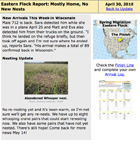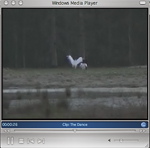Many western cranes are still in the central flyway, while at least 89 of the new eastern flock are confirmed home. No new nests, but the first hatchling for the new Class of 2010 is expected May 2 at the captive breeding center in Maryland. The journal question takes stock of the flock. Visit International Migratory bird Day with a podcast. What could be the trouble with the crane in this photo? Our slideshow has the answer.
Today's Report Includes:
- Migration News: Map and Field Reports
- Journal Topic: Taking Stock of the Flock
- Conservation: International Migratory Bird Day
- Links: Helpful Resources to Explore
- Year-end Evaluation: Please Share Your Thoughts
Image of the Week
 Western Flock News |
 Data /Map |
 Eastern Flock News and Finish Line |
|
"I am slightly baffled at the low number of reports this spring," says Lea Craig-Moore from Canada. But she has some ideas why sightings for this flock of 262 are low. More |
|
Home on the nesting grounds are 80 confirmed arrivals including the flock's oldest female and all but one of the 2009 crane-kids. Any nests? Sara tells more. |
Even though 262 whoopers are migrating, there aren't many people to spot the 262 whoopers of the natural flock flying from Texas to Canada across the wide open prairies. More folks live in the migratory path of the new eastern flock, but the number of cranes is smaller. Still, citizen scientists are spotting cranes in both flyways. Example:
Necedah Wildlife Refuge is about 20 miles to the west of Adams-Friendship Middle School in Wisconsin. Teacher Linda Ruhland-Stage reported seeing Whooping cranes on her way to school April 28! "Many of the students have seen the whoopers in the wild," she said. How exciting is THAT? In ten years, the whooping crane population in the eastern US has gone from 0 to about 103. Your question:
- The goal is 25 breeding pairs from 125 cranes released into the flyway by 2020. When do you predict they'll make it? Give reasons for your thinking. What percentage of the goal has been achieved?
 |
| This spring's first whooper egg at Patuxent Wildlife Research Center in Maryland is expected to hatch May 2. We'll introduce you to the first new chicks for the Class of 2010 in our next report on May 18! |
Our rapidly changing world poses countless threats to the survival of migratory birds, and not just whooping cranes. Each year, some 350 bird species, including Whooping cranes, migrate between summer and winter habitats. Their epic flights span state and national boundaries and have inspired unique partnerships dedicated to bird conservation. This year's theme for International Migratory Bird Day is "The Power of Partnerships" in bird conservation. Biologists Tom Stehn, Lea Craig-Moore and Richard Urbanek; aviculturalist Sara Zimorski; trackers Eva Szyszkoski and Matt Strausser; Operation Migration pilots Joe, Brooke, Chris and Richard — all these friends who give you news through Journey North— are in the partnership helping to bring back Whooping cranes from the brink of extinction.
IMBD festivities will happen May 8 at Disney Animal Kingdom and Operation Migration take will take part. But you can visit right now by clicking on last year's podcast made by Mark Chenoweth, who was at the Operation Migration (OM) exhibit with our friends Joe Duff and Brooke Pennypacker. What did visitors ask Brooke and Joe? Hear interviewer Mark Chenoweth talk with students who visited the OM booth. And listen Joe's answer to a question YOU may have asked: Why could the Class of 2009 crane-kids return to Wisconsin so much faster than they got there?

Hear Mark Chenoweth's podcast
(13 min.) with excerpts from the past few years of the International Migratory
Bird
Day celebrations at Disney Animal Kingdom in early May.
- Teachers/Overview: About This Study
- Image of the Week: What could be the trouble?
- Field Report: Western Flock
- Field Report: Eastern Flock
- Lesson: A Day in the Life of a MIgrating Whooper
- Lesson: The Challenge of Whooping Crane Survival: Learning from Life Histories
- Slideshow: Lucky LaCreek Pair: Struggle, Strength, Survival
- Podcast: IMBD Interviews at Disney Animal Kingdom
- Video Clip and Activity: Dance Like the Cranes
- Mapping and Record Keeping: Track the Migration
- Making Good Sightings: Official WCEP Reporting form
- Record Keeping: Arrival Log for Eastern Flock
- Journal: Downloadble Journey North Journal Pages
Will you take a few minutes to complete our Year-end Evaluation? With your help, we can we document Journey North's reach, impact and value. We need comments like yours to keep the program going and growing.
-
Year-end Evaluation: Please Share Your Thoughts

The FINAL Whooping Crane Migration Update Will Be Posted on May 14, 2010.




